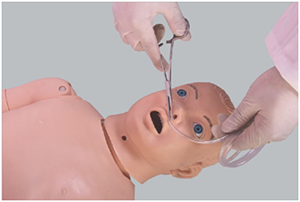Welcome to visitShanghai Chinon medical Model & Equipment Manufacturing Co., LTD
Pediatric nasal feeding tube models play a critical role in medical education and training, with one of its core functions being to simulate clinical operations so that healthcare workers can practice and improve their skills in a safe, risk-free environment. So, can the pediatric nasogastric tube model really restore clinical operation? Here is an in-depth look at this question.
Secondly, from the perspective of operation process, the model can simulate the complete feeding tube insertion process, including the steps of cleaning the nasal cavity, lubricating the stomach tube, intubation, fixation, etc. The medical staff can practice these operations repeatedly on the model to master the correct operation methods and techniques. In addition, some advanced models can also simulate the abnormal conditions that may occur in the clinic, such as intubation difficulties, gastric tube displacement, etc., so as to help medical personnel learn to cope with and deal with these problems. This simulation not only improves the operational skills of the medical staff, but also enhances their resilience and self-confidence.

However, although the pediatric nasogastric tube model can be well restored to clinical practice in terms of anatomy and operation procedure, it still has some limitations. For example, models cannot fully simulate the emotional and physical responses of real children, such as pain, discomfort, or fear. These emotional factors often have an important impact on health care workers and children in clinical practice, so the model cannot completely replace the real clinical environment.
In addition, the complexity and variability of clinical operation are also difficult to completely restore the model. Each child's situation is unique, and medical staff need to make judgments and decisions according to the specific circumstances in clinical operation. Models do not provide simulations of this complexity and variability, so the skills that healthcare professionals practice on models need to be tested and refined in practice.
In summary, the pediatric nasogastric tube model has certain advantages in restoring clinical operation, but it also has certain limitations. It can provide a safe and controllable practice platform for medical staff, help them master the correct operation methods and skills, improve the resilience and self-confidence. However, medical staff also need to combine model training with actual clinical operation, accumulate experience and improve skills, in order to better provide high-quality nursing services for children.
|
NEXTпјљ The intramuscular injection module facilitates skill development training
LASTпјљAdvanced cardiopulmonary resuscitation Model: An accelerator for improving your first aid skills |
Return list |